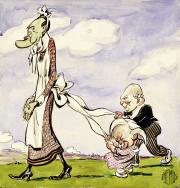The Shemus cartoons
Published in 20th-century / Contemporary History, General, Issue 5 (Sep/Oct 2009), News, Volume 17
‘The Carson Kids’ by ‘Shemus’—Lloyd George and Sir Hamar Greenwood (chief secretary for Ireland) clutching Sir Edward Carson’s apron strings. (Freeman’s Journal, November 1920)
The Freeman’s Journal published some 300 Shemus cartoons between 1920 and 1924. These were remarkably hard-hitting comments on the events of this period, reflecting the paper’s editorial stance. Up to the truce of July 1921, which led on to the Anglo-Irish Treaty in December, the main thrust of the cartoons was against the increasingly brutal nature of British rule in Ireland. Thereafter, they targeted principally the new government of Northern Ireland and anti-Treaty elements in the new Irish Free State.
The cartoonist was Ernest Forbes (1879–1962), an Englishman who had come to Ireland to join the Freeman’s staff in 1920. He was later a well-known landscape artist and portrait-painter in London and in his native Yorkshire. He used a number of pseudonyms in his long career, and even ‘Ernest Forbes’ was a contrivance: his full name was Ernest Forbes Holgate and he dropped the surname when signing his work. The pseudonym ‘Shemus’ was exclusive to the Freeman’s Journal.
In December 2006 the National Library of Ireland acquired an archive of about 280 items by Forbes, mostly original drawings of Shemus cartoons. This collection contains the originals of over three-quarters of the Shemus cartoons published by the Freeman’s Journal, together with about 30 more that appear never to have been published. It contains, in addition, some original caricature portraits of notable persons by Shemus and original drawings of other cartoons, which Forbes signed as ‘Cormac’. The latter are in a style markedly different from the Shemus cartoons and portraits and are usually concerned with sporting events, such as horse racing, at Irish or British venues. The portraits and the Cormac cartoons were also published in the Freeman’s.
The cartoon reproduced here dates from November 1920, a particularly vicious time in the Irish War of Independence. It demonstrates both Shemus’s skill in caricature and his practice of placing his subjects in comical situations in order to suggest a particular angle on events. Entitled ‘The Carson Kids’, it depicts Lloyd George and Sir Hamar Greenwood, then chief secretary for Ireland, as children clutching Sir Edward Carson’s apron strings. The implication is that, since Lloyd George is dependent on the support of the Conservative Party to continue in office, Carson can dictate British policy in Ireland. The Freeman’s main editorial published on the same day noted that ‘reprisals [by the military] still continue’ and asked: ‘Will [Lloyd George] call off his dogs of war, or will he cry “Havoc!” and whoop them at the bidding of Sir Edward Carson?’
Forbes retained an essentially British mind-set throughout his sojourn in Ireland. He was at his best when treating of his Irish subject-matter from the perspective of British politics and focusing on British politicians. His work for the Freeman’s during the War of Independence mirrored the British liberal critique of British policy in Ireland, a critique based principally on what British journalists were reporting from Ireland. When the British presence in Ireland wound down in 1922 and Forbes was deprived of a British context for his work, his cartoons became much less subtle and insightful—and eventually he produced fewer of them. Nevertheless, his work continued to appear in the Freeman’s until it ceased publication in December 1924. HI
Felix M. Larkin wrote the introduction and explanatory notes for Terror and Discord: the Shemus cartoons in the Freeman’s Journal, 1920–1924 (A&A Farmar, 2009).
















